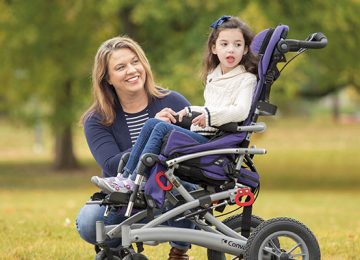
Learn how Brineura may help your child
Brineura helped maintain children’s ability to walk, with or without assistance, over approximately 2 years of treatment


Discover the path toward treatment with Brineura
Every child’s journey with Brineura will be different.
We’re here for you and your family with resources

Brineura is contraindicated in patients with:
- any sign or symptom of acute, unresolved localized infection on or around the device insertion site (e.g., cellulitis or abscess); or suspected or confirmed CNS infection (e.g., cloudy CSF or positive CSF gram stain, or meningitis)
- any acute intraventricular access device-related complications (e.g., leakage, extravasation of fluid, or device failure)
- ventriculoperitoneal shunts
Brineura has not been studied in pregnancy or lactation.
Safety and effectiveness in pediatric patients below 3 years of age have not been established.
- Patients with any sign or symptom of acute or unresolved localized infection around the device insertion site (eg, cellulitis or abscess) or suspected or confirmed central nervous system (CNS) infection (eg, cloudy cerebrospinal fluid [CSF] or positive CSF gram stain, or meningitis)
- Patients with active intraventricular access device-related complications (eg, leakage, device failure, or device-related infection, including meningitis)
- Patients with shunts used to drain extra fluid around the brain
Administration: Brineura is only given by infusion into the fluid of the brain (known as an intraventricular injection) and using sterile technique to reduce the risk of infection. An intraventricular access device or port must be in place at least 5 to 7 days prior to the first infusion.
- Prior to administration, it is important to discuss your child’s medical history with their doctor
- Tell the doctor if your child is sick or taking any medication and if they are allergic to any medicines
- Brineura is not recommended for use in patients less than 37 weeks post-menstrual age (gestational at birth plus post-natal age) or those weighing less than 2.5kg.
Meningitis and other device-related infections: Intraventricular access device-related infections, including meningitis, were observed with Brineura treatment. Infections required treatment with antibiotics and removal of the access device. If any signs of infection or meningitis occur, contact your child’s doctor immediately. The signs and symptoms of infections may not be readily apparent in patients with CLN2 disease.
- Your child’s doctor should vigilantly be looking for signs and symptoms of infection, including meningitis, during treatment with Brineura
- Your child’s doctor should inspect the scalp and collect samples of your child’s CSF prior to each infusion of Brineura, to check for infections and that there is no device failure
- Signs of infection on or around the device insertion site may include redness, tenderness, or discharge
Device-related complications such as device leakage, device failure, leakage of CSF fluid, or bulging of the scalp around or above the intraventricular access device have occurred. In case of intraventricular access device-related complications, Brineura infusions may be discontinued.
Material degradation of the intraventricular access device reservoir was reported after approximately 4 years of administration, which may impact the effective and safe use of the device. During testing such material degradation was recognized after approximately 105 perforations of the intraventricular access device. The intraventricular access device should be replaced prior to 4 years of single-puncture administrations, which equates to approximately 105 administrations of Brineura.
The most common side effects reported during Brineura infusions included:
- Fever, problems with the electrical activity of the heart, decreased or increased protein in the fluid of the brain, vomiting, seizures, device-related complications, hypersensitivity, collection of blood outside of blood vessels (hematoma), headache, irritability, increased white blood cell count in the fluid of the brain, device-related infection, slow heart rate, feeling jittery, and low blood pressure.
- The most frequent adverse reactions reported in patients less than 3 years of age treated with BRINEURA were similar to those observed in patients greater than 3 years of age except for hypersensitivity reactions, which were reported in 5 of 8 (63%) in patients less than 3 years of age at baseline compared with 0 of 6 in patients greater than 3 years of age at baseline. The most common manifestations of hypersensitivity were fever and vomiting. Such symptoms resolved over time or with administration of antipyretics, antihistamines and/or corticosteroids. Symptoms of severe hypersensitivity reactions (e.g., anaphylaxis) included rapid heartbeat, throat tightness, coughing, wheezing, trouble breathing, rash, diarrhea, hypotension, increased body temperature and vomiting.
The risk information provided here is not comprehensive. Talk to your healthcare provider to learn more or for medical advice about any side effects.
You may report side effects to BioMarin at 1-866-906-6100.
You are encouraged to report negative side effects of prescription drugs to the FDA. Visit www.fda.gov/medwatch or call 1–800-FDA-1088.
Please see accompanying full Prescribing Information with important warning for risk of anaphylaxis or visit www.Brineura.com.


